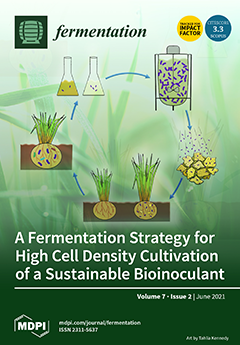Among 39 pentose-utilizing lactic acid bacteria (LAB) selected from acid-forming bacteria from the midgut of Eri silkworm, the isolate WX1 was selected with the highest capability to produce optically pure
l-lactic acid (
l-LA) from glucose, xylose and arabinose with furfural-tolerant
[...] Read more.
Among 39 pentose-utilizing lactic acid bacteria (LAB) selected from acid-forming bacteria from the midgut of Eri silkworm, the isolate WX1 was selected with the highest capability to produce optically pure
l-lactic acid (
l-LA) from glucose, xylose and arabinose with furfural-tolerant properties. The isolate WX1 was identified as
Enterococcus mundtii based on 16S rDNA sequence analysis. The conversion yields of
l-LA from glucose and xylose by
E. mundtii WX1 were 0.97 and 0.68 g/g substrate, respectively. Furthermore,
l-LA production by
E. mundtii WX1 in various glucose-xylose mixtures indicated glucose repression effect on xylose consumption. The coculture of
E. mundtii WX1 and
Lactobacillus rhamnosus SCJ9, a homofermentative LAB capable of producing
l-LA from glucose clearly showed an improvement of
l-LA production from 30 g/L total glucose-xylose (6:4). The results from Plackett–Burman design (PBD) indicated that Tween 80, MnSO
4 and yeast extract (YE) were three medium components that significantly influenced (
p < 0.05)
l-LA production using the coculture strategy in the presence of 2 g/L furfural. Optimal concentrations of these variables revealed by central composite design (CCD) and response surface methodology (RSM) were 20.61 g/L YE, 1.44 g/L Tween 80 and 1.27 g/L MnSO
4. Based on the optimized medium with 30 g/L total glucose-xylose (6:4), the maximum experimental
l-LA value of 23.59 g/L reflecting 0.76 g/g substrate were achieved from 48 h fermentation at 37 °C.
l-LA produced by coculture cultivated under standard MRS medium and new optimized conditions were 1.28 and 1.53 times higher than that obtained from single culture by
E. mundtii WX1, respectively. This study provides the foundations for practical applications of coculture in bioconversion of lignocellulose particularly glucose-xylose-rich corn stover to
l-LA.
Full article





